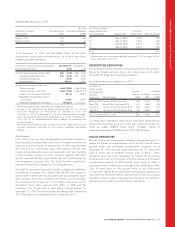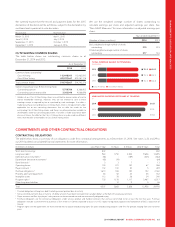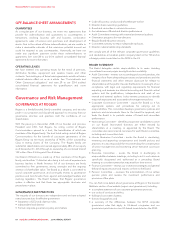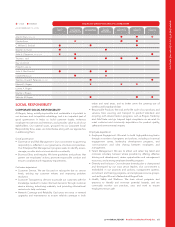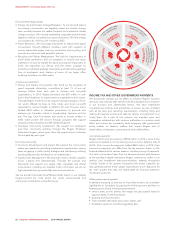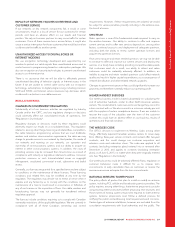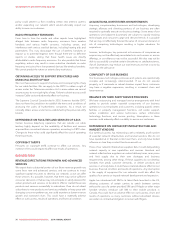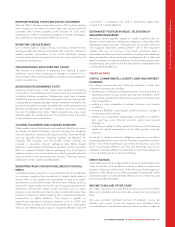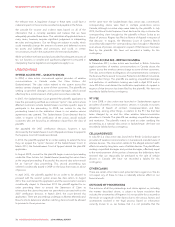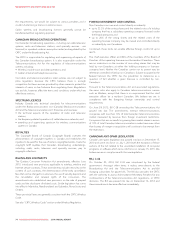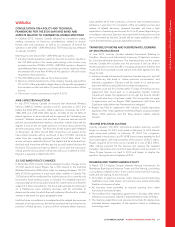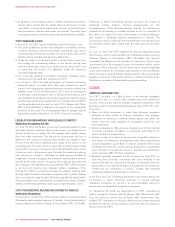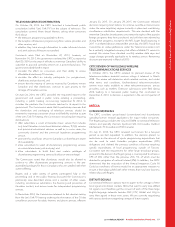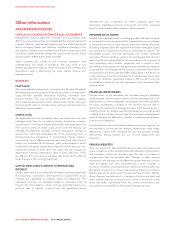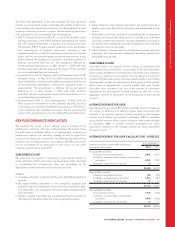Rogers 2014 Annual Report Download - page 75
Download and view the complete annual report
Please find page 75 of the 2014 Rogers annual report below. You can navigate through the pages in the report by either clicking on the pages listed below, or by using the keyword search tool below to find specific information within the annual report.
MANAGEMENT’S DISCUSSION AND ANALYSIS
INCREASE IN BRING YOUR OWN DEVICE CUSTOMERS
With the CRTC’s Wireless Code introduced in 2013 limiting wireless
term contracts to two years from three years, the number of BYOD
customers with no-term contracts could increase. As such, these
customers are under no contractual obligation to remain with Rogers,
this could have a material adverse effect on our churn.
INVENTORY OBSOLESCENCE
Our inventory balance mainly consists of wireless handset devices,
which generally have relatively short product life cycles due to frequent
wireless handset introductions. If we cannot effectively manage
inventory levels based on product demand, this may increase the risk
of inventory obsolescence.
ORGANIZATIONAL STRUCTURE AND TALENT
The industry is competitive in attracting and retaining a skilled
workforce. Losing certain employees or changes in morale due to a
restructuring or other event could affect our revenue and profitability in
certain circumstances.
INCREASING PROGRAMMING COSTS
Acquiring programming is the single most significant purchasing
commitment in our Cable television business and is also a material cost
for Media television properties. Programming costs have increased
significantly over the past few years, particularly with the recent growth
in subscriptions to digital specialty channels. Increased competition for
programming rights to popular properties from both traditional linear
television broadcasters and digital competitors continue to increase
the cost of programming rights. Higher programming costs could
adversely affect the operating results of our business if we are unable
to pass on these costs to subscribers.
CHANNEL PLACEMENT AND CHANNEL BUNDLING
Unfavourable channel placement could negatively affect the tier status
and results of certain of Media’s channels, including The Shopping
Channel, Sportsnet, Sportsnet 360, Sportsnet ONE, Sportsnet World,
and our specialty channels, including Outdoor Life Network, FX
(Canada), FXX (Canada), and G4 Canada. Certain channels are
included in favorable channel packaging with BDUs. Digital
distribution technologies and potential regulatory rulings may allow
BDUs to implement flexible channel packaging. This could have a
negative impact on our results and some industry specialty networks
may not survive in such an environment. See also “Television Services
Distribution” section under Cable Regulation.
MIGRATING FROM CONVENTIONAL MEDIA TO DIGITAL
MEDIA
Our Media business operates in many industries that can be affected
by customers migrating from conventional to digital media, which is
driving shifts in the quality and accessibility of data and mobile
alternatives to conventional media. We have been shifting our focus
towards the digital market to limit this risk. Increasing competition for
advertising revenue from digital content providers such as search
engines, social networks and Internet video content alternatives have
resulted in advertising dollars migrating from conventional television
broadcasters to digital platforms. The impact is greater on
conventional over-the-air broadcast networks such as CityTV and
OMNI that do not have a second revenue stream from subscription
revenue. Our Media results could be negatively affected if we are
unsuccessful in anticipating the shift in advertising dollars from
conventional to digital platforms.
OUR MARKET POSITION IN RADIO, TELEVISION OR
MAGAZINE READERSHIP
Advertising dollars typically migrate to media properties that are
leaders in their respective markets and categories, particularly when
advertising budgets are tight. Although most of our radio, television
and magazine properties currently perform well in their respective
markets, this may not continue in the future. Advertisers base a
substantial part of their purchasing decisions on ratings and readership
data generated by industry associations and agencies. If our radio and
television ratings or magazine readership levels decrease substantially,
our advertising sales volumes and the rates that we charge advertisers
could be adversely affected.
FINANCIAL RISKS
CAPITAL COMMITMENTS, LIQUIDITY, DEBT AND INTEREST
PAYMENTS
Our capital commitments and financing obligations could have
important consequences including:
• requiring us to dedicate a substantial portion of cash provided by
operating activities to pay interest, principal and dividends, which
reduce funds available for other business purposes including other
financial operations;
• making us more vulnerable to adverse economic and industry
conditions;
• limiting our flexibility in planningfor,and/orreactingto,changesin
our business and/or industry;
• putting us at a competitive disadvantage compared to competitors
who may have more financial resources and/or less financial
leverage; or
• restricting our ability to obtain additional financing to fund working
capital and capital expenditures and for other general corporate
purposes.
Our ability to satisfy our financial obligations depends on our future
operating performance and economic, financial, competitive and other
factors, many of which are beyond our control. Our business may in the
future not generate sufficient cash flow and financings may not be
available to provide sufficient net proceeds to meet these obligations
or to successfully execute our business strategy.
CREDIT RATINGS
Credit ratings provide an independent measure of credit quality of an
issuer of securities, and can affect our ability to obtain short-term and
long-term financing and the terms of the financing. If rating agencies
lower the credit ratings on our debt, particularly a downgrade below
investment grade, it could adversely affect our cost of financing and
access to liquidity and capital.
INCOME TAXES AND OTHER TAXES
We collect, pay and accrue significant amounts of income and other
taxes such as federal and provincial sales, employment and property
taxes.
We have recorded significant amounts of deferred income tax
liabilities and current income tax expense, and calculated these
amounts based on substantively enacted income tax rates in effect at
2014 ANNUAL REPORT ROGERS COMMUNICATIONS INC. 71


